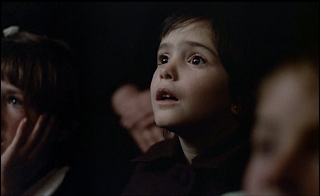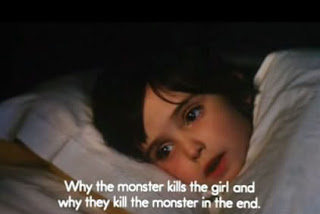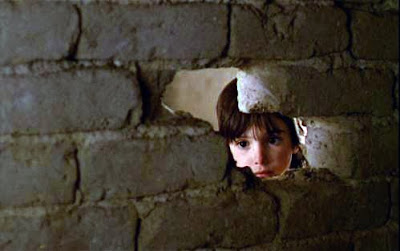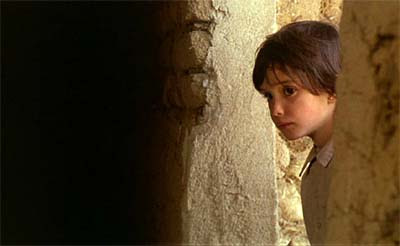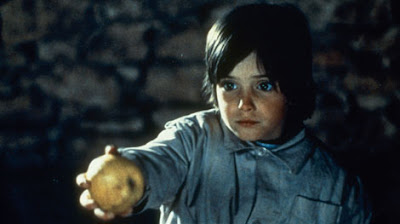But my loyal readers here also know that I'm a fan of movies from the era before sound technology changed cinema forever in 1927. You all know that I'm a regular fanboy of the silent-era comedies, notably (but not exclusively) those of Charlie Chaplin, Buster Keaton, and Harold Lloyd. Both Lloyd ("Haunted Spooks," 1920) and Keaton ("The Haunted House," '21) offered their own twists on Halloween-worthy tales, though naturally in shorts showcasing their distinctive comic spins.
On the other hand, some of horror film history's great features likewise come from those years. I'm talking such genre-shaping classics as The Golem (1915/1920), The Cabinet of Dr. Caligari (1919), John Barrymore's Dr. Jekyll and Mr. Hyde (1920), Nosferatu (the first "Dracula" in 1922), The Phantom of the Opera (1925), The Cat and the Canary (1927), and The Man Who Laughs (1928).
So I'm going to pick one I haven't pulled out of the DVD shelves for several years. Out of all of them, it's the film that probably best falls under the subgenre category that cinema historians and academics classify as Holy Crap WTF That's Weird. It's from Sweden, 1922.
And yeah, what was it about 1922 anyway? The same year Murnau's Nosferatu showed the world how to make a vampire movie, and Fritz Lang's Dr. Mabuse took a near-supernatural journey to Berlin's criminal underworld, a film opened in Sweden that was to become notorious for its bold depictions of torture, madness, carnality, and — most memorably — horrific acts performed by and for bestial, nightmarish demons, including Satan himself. But while Nosferatu, The Phantom of the Opera, and all the others presented their stories as fiction, filmmaker Benjamin Christensen's Häxan appeared in the guise of a documentary, its very realism at the heart of its hypnotic allure and its scandalous notoriety.
Officially banned outside Sweden for decades due to graphic imagery and an unabashed anti-clerical theme, Häxan has grown into a culty sort-of-classic that for over half a century you might hear about but rarely, if ever, got a chance to actually see.
Is it true that it displays witches cavorting naked with lusty devils? Is a baby really drained of blood before it's tossed into a stew pot? What's this about women lining up to kiss Satan's bulbous ass? Inquisitional torture? Flying on broomsticks? Hysterical nuns? Sacrilege and perversion? Demonic orgies? Otherworldly monstrosities emerging from between an old crone's legs? And it's a documentary? And is there really a version narrated by Beat generation writer and hip icon William S. "The Naked Lunch" Burroughs, complete with acid jazz soundtrack?
It's all true. Häxan (pron. "hexen," meaning "witches") was long available only in rare, diminished forms, the most well known being a 1968 re-edit given the title Witchcraft Through the Ages. That abbreviated version sports the add-on Burroughs' narration and an anarchic musical score featuring jazz violinist Jean-Luc Ponty.
The best way to check out this infamous curio is the DVD under the Criterion Collection logo. Criterion's disc offers a strikingly beautiful print of the fully restored and re-tinted Häxan, pairing it with the Burroughs version. Its superb audio track features a new score recreated from the film's original list of musical cues.
Plus, Criterion maintains its reputation for delivering a generous assortment of supportive supplemental material — including an audio commentary by Danish silent film scholar Casper Tybjerg, outtakes and test shots, and click-through selections from the centuries-old documents writer/director Christensen used for his diabolical source material.
I'll get into those later on in this post. For now, though, let's pull back the cowl on what I like to call...
The Reefer Madness of devil-worshipping witchcraft movies
It should be stated that Häxan is a documentary to roughly the degree that Citizen Kane is a biopic of William Randolph Hearst. Ostensibly an exposé of religious persecution born from ignorance of science, Häxan can be easily classified as a masterpiece of silent horror — or, when filtered through the bong water of the psychedelic '60s to become Witchcraft Through the Ages, as a trippy exercise in surreal pop filmmaking extravagance.
Christensen drew information and inspiration from the dreaded Malleus Maleficorum (The Hammer of Witches), a 15th century how-to manual on the detection, persecution, and torture of witches, a book Christensen called "the most scurrilous document in the history of the world." Häxan blends documented fact, outrageous fiction, objective observation, hallucination, social commentary, and different levels of representation to keep us from ever being too certain what the director is up to.
Christensen opens the film with a calculated deception titled "Chapter 1: Sources," a dry lecture complete with slideshow of medieval woodcuts and a pointer stick entering the frame to guide our education. So for the first thirteen minutes or so, we're given a classroom course in the cosmology, mythology, and social orders that generated witchcraft hysteria, a contagion that ravaged Europe like a virulent plague throughout the Middle Ages. The approach is academic and condescending toward the ignorance and pious malice that turned harmless ancient folk beliefs into powerful tools for repression and Church-sanctioned mass murder.
But that's just the canny set-up for Häxan's first twist. "Chapter 2: 1488" dramatizes a witch's lair in the darkest of Dark Ages. The decomposed corpse of a hanged thief is relieved of a finger ring — and the finger — as the witch comments that from the odor it's clear that the poor bugger was left swinging a bit too long. She then drops the finger into a potion vat. Various acts of witchery and deviltry play out on elaborate sets and with clever special effects (including stop-motion animation).
The intertitle cards continue a sense of the lecture mode, but soon the film slides into audacious theatricality, replacing a lecturer's notes with boldly visualized vignettes that pull us into a medieval world where demonic beings and profane witches' Sabbaths are as real as the filth, diseases, and squalid conditions that marked European life for centuries.
Christensen goes to great lengths to underline the fact that to the medieval mind sorcery and Satanic presence were not mere superstition. This deeply rooted belief in the existence of witchcraft and its heretical nature bred an "antidote" that was in reality every bit as pernicious as the Hell-spawned forces were believed to be.
So in "Chapter 3: The Trials" and "Chapter 4: The Torture" we witness a clerical tribunal employing brutal confessional aids on an old woman. It's her forced confession that springs the viewer into the most eye-popping and famous scenes in Häxan. As she describes giving birth to demonic "children" — nightmarish insectoid beings straight out of H.P. Lovecraft — and a Satanic Sabbath, women young and old revel in gleeful desecration of holy symbols and partake of unholy acts that include flying through the air on broomsticks, feasting on toads and unbaptized babies, and cheerfully having sex with hideous demons.
Subsequent chapters — there are seven in all — further the roles of the witch-hunters. These religious zealots moved in packs from village to village, ready to perform the most extreme penalties on anyone considered the least bit suspicious or deserving. A victim's innocence was at best an inconvenience difficult to prove, and even that proof might come via methods that left the accused just as dead as a confession would leave her.
As if the devils Sabbath scene wasn't sufficient, Christensen guaranteed Häxan's notoriety by depicting the Church's holy officers as fat, leering, deceitful barbarians more interested in sadism than in dispensing their Lord's benevolent justice. This anti-clericalism may have endeared Häxan to the Surrealists, but in predominantly Catholic countries it helped arm the censors with further ammunition to use against it.
Not even convents are immune to Satan's devastating influences, even though flagellation and self-torture were means of purifying oneself against the rampant diabolism. When Sister Cecilia is overcome by his tempting power, the entire nunnery is immediately gripped by madness, blasphemy, and a frenzy of dancing, a scene that's as humorous as it is unnerving.
In Häxan's final scenes, "Chapter 7: 1921," Christensen returns his narrative to solid documentary mode. He parallels the medieval practitioners and victims of witchcraft with modern victims of mental disorder, Freud's concept of female hysteria, and other more (relatively) enlightened social stigmas. The pop psychology and real-world flatness of this section render it less engaging than what came before, and sometimes Christensen's reach for meaning yields unintended results — a statement that witches no longer fly on broomsticks cuts to a woman pilot taking off in her biplane. Similarly, a sauna is equated with a witch's cauldron.
So, yep, there's a taint of 1920s misogyny here. It's mild and even rather quaint now even as it accidentally sets up some parallel between the horrific misogynist hysteria of the Middle Ages and the more antiseptic yet still harmful attitudes prevalent five centuries later.
It's all mesmerizing, voyeuristic, and often more than a bit goofy. The film's uneven flow and varying tone range from ribald humor to macabre excess to coldly objective scientific study. Often it's so bold even by today's standards that it seems as though Christensen was curious to see how much he could get away with. And fortunately it has all aged remarkably well.
The Devil's in the details
Christensen is one of the unsung technical masters of the silent era. Born in Denmark in 1879, he had a varied career before he entered the Danish film industry as an actor and writer in 1912. His early films have a visual sophistication that has invited comparisons to D.W. Griffith and other renowned innovators.
In Häxan, Christensen's dense atmosphere of gloomy superstition is bolstered by an expert use of light and shadow. Silhouette, tableau, and framing are often used for stark theatrical effect. This mastery of lighting effects, combined with beautiful — some might say painterly — compositions, found expression in Richard Louw's remarkable scenery and the photography by Johan Ankerstjerne, Svensk Filmindustri's chief cinematographer. In its day, Häxan was notorious within the Swedish film world for its abundant use of close-ups, then considered improper because the technique blew up the human face in all its raw nakedness to unnatural proportions.
To modern eyes, the special effects are crude but no less effective for it. The demons are masterworks of design and makeup effects. The massive, tongue-wagging Satan — played by Christensen himself — is a realistic depiction of medieval imagery, masculine and lustful and obscene. A skeletal horse walking through a demonic bacchanal is clearly an old-fashioned panto technique, but it's damn creepy all the same. A miniature stop-motion demon clawing through a door remains a startling sight, the camera dispassionately observing its work as if we're watching a documentary on termites.
As an early exercise in near-surrealism, atmosphere, and imaginative techniques, Häxan's influence on 20th century filmmakers, notably Luis Buñuel and Val Lewton, should not be underestimated.
After Häxan, Christensen's reputation rested mainly on his (note the title) Seven Footprints to Satan (1929), an American-made satire of — get this — Hollywood musicals.
William S. Burroughs and Witchcraft Through the Ages
 The best-known incarnation of Häxan is the shortened re-edit titled Witchcraft Through the Ages and narrated by William S. Burroughs, of The Naked Lunch fame. This 1968 release was prepared by British filmmaker and distributor Antony Balch, who had previously worked with Burroughs in making a number of short films. Percussionist Daniel Humair wrote the chaotic '60s-bop score. The jazz combo features, among others, Jean-Luc Ponty on violin.
The best-known incarnation of Häxan is the shortened re-edit titled Witchcraft Through the Ages and narrated by William S. Burroughs, of The Naked Lunch fame. This 1968 release was prepared by British filmmaker and distributor Antony Balch, who had previously worked with Burroughs in making a number of short films. Percussionist Daniel Humair wrote the chaotic '60s-bop score. The jazz combo features, among others, Jean-Luc Ponty on violin. Burroughs' voice opens Witchcraft Through the Ages with a droning incantation against a black screen. His one-note monotone sets the style for the remainder of his narration, which consists primarily of English translations of the original intertitle cards. (The few intertitles that remain are in an English translation.) It says something about the power of silent cinema that Burroughs' narration adds nothing to the goings-on unfolding on the screen. Indeed, it detracts from the full scope of Christensen's work
Still, it's a memorable curiosity that remains evocative of the 1960s and an era of experiments in expression. The score fits the imagery quite well, though it may come across as harsh or abrasive to modern ears.
Witchcraft Through the Ages clocks in at an hour and 16 minutes, compared to Häxan's hour and 45. Possibly still popular on college campuses, Witchcraft Through the Ages might just be best viewed through a haze of sweetly scented smoke.
About the Criterion DVD
Criterion's disc presents the Swedish Film Institute's restoration of Häxan, which began with the creation of a fine-grain master from the original camera negative. The intertitles, most of which had been lost, were replaced with new film titles. They're presented here in the original Swedish with optional English subtitles.
Then the SFI recreated the tinting that had originally been present in theatrical prints of Häxan, bringing this version much closer to what audiences might have seen at the time of its original release.
Naturally some defects in the film stock remain. Expect minor speckling and a little wavery framing on the left-hand side. Nonetheless, this print is superb. Detail and depth are remarkably crisp. The black levels — vital in this film — are solid and true. The tinting tones, chiefly dark blues and ambers, enhance the visuals without appearing oversaturated.
In a word, it looks great.
The musical score
Silent films were seldom watched in actual silence. Huge cinema "palaces" often featured chamber orchestras. For this Criterion Collection release, film music specialist Gillian Anderson attempted to recreate the music played at Häxan's Danish premiere on November 7, 1922. She based the score on a list of musical cues printed in the theater's weekly program notes and conducted an 11-piece ensemble from the Czech Film Orchestra in Prague in June 2001.
A menu item called The Häxan Score provides notes on the score plus a playlist of the 18 titles used to recreate the original music. Familiar titles include segments from Schubert's Unfinished Symphony and Rosamunde Overture, Wagner's Tannhauser, Mozart's Titus Overture, Beethoven's Moonlight Sonata, and Ave Maria. For a nifty feature, click the music title to jump to the segment in Häxan that features the music selected.
The score is available in Dolby Digital 5.0 and Dolby Digital 2.0 stereo. Clean, solid, and free of distortion, both options sound fine.
Witchcraft Through the Ages is also presented in its original theatrical aspect ratio of 1.33:1 and likewise was derived from a 35mm fine-grain master. It's untinted and displays a great deal more wear than the restoration of Häxan. But it looks and sounds fine. Its Jean-Luc Ponty soundtrack is available only in Dolby 1.0.
The supporting supplements
The scene-specific audio commentary track is provided by Danish silent film scholar Casper Tybjerg. Erudite and with an encyclopedic knowledge of things Christensen, Tybjerg may not be the most riveting audio-track scholar (Dr. Mabuse's David Kalat having set a gold standard), but he keeps his commentary moving forward and doesn't permit the great gaps of dead air that dog the commentaries of some other "historical" discs. He has a pleasing voice and does a thorough job of fleshing out the context of Christensen's work, illuminating the production itself, and detailing the sources that Häxan was built from. Among other worthwhile moments, Tybjerg soundly refutes the common figure (used in Häxan) of eight million women put to death during the era of the witch hunts. Explaining where that figure originated, Tybjerg gives us a more accurate figure of some 40-50 thousand women murdered — still a ghastly sum by any measure.
In 1941, Christensen filmed an eight-minute Director's Introduction for a re-release of Häxan. It's offered here in Swedish with English subtitles. Addressing his audience on a small set that looks more like a doctor's office than a movie studio, Christensen notes that even in our era of sound technology adding a vocal track to Häxan would diminish its effect. He then offers a preamble for things to come with the intellectual objectivity of a genial scientist introducing a biology lecture. One of the highlights of this segment is a plausible theory behind the common witches' trope of flight through the air.
Bibliothèque Diablolique provides an annotated click-through tour of the centuries-old woodcuts, church wall paintings, and other illustrations Christensen used in "Chapter 1: Sources." The illustrations and commentary occupy roughly 115 frames, including an extensive bibliography by Casper Tybjerg. Fans of The Exorcist will recognize the ancient Near East statue of a winged demon seen in that movie.
A click-through stills gallery contains 40 photographs from the sets and production of Häxan.
A four-and-a-half minute collection of Outtakes gives up footage from a reel of test shots that include pre-production footage from the convent set, rehearsal close-ups of an actress playing a nun "trying out a variety of ungodly titters," and test shots for the scenes of witches in flight — with Christensen himself playing the flying witch.
Finally, the keep-case's pull-out liner notes booklet (reproduced at Criterion's site) is a handy compendium of facts and commentary by Chris Fujiwara, who writes on film for Hermenaut, The Boston Phoenix and other publications. He details Häxan's history and influence in a casual yet scholarly manner. The booklet also includes two pages of insight into the music of Häxan, prepared by Gillian Anderson.
Nightmares before Christmas
Whether as a unique feature of your annual Halloween video fest, or as an addition to the growing collection of silent classic restorations becoming available on DVD, or if your aim is to induce a lifetime of nightmares in small children, this is the disc you're looking for. As an exegesis on the damaging effects of superstition and religious distortion used as a pretext for harming others — sadly, a sickness still prevalent throughout the world today — it makes a fine companion to Carl Sagan's excellent treatise on pernicious fantasies both ancient and modern, The Demon-Haunted World. And as another example of the work that The Criterion Collection is doing for us cinephiles, this restoration of a remarkable work by a filmmaker who deserves greater name recognition gives, you might say, the Devil his due. (All apologies to Peter Cook.)
Music: Susannah McCorkle
Near at hand: The Film Director's Intuition by Judith Weston








































